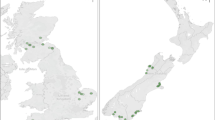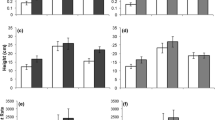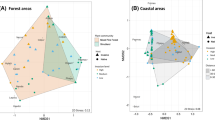Abstract
One of the most cited hypotheses explaining the inordinate success of a small proportion of introduced plants that become pests is the ‘natural enemies hypothesis’. This states that invasive introduced plants spread rapidly because they are liberated from their co-evolved natural enemies. This hypothesis had not been properly tested until recently. Previous reviews on this topic have been narrative and vote counting in nature. In this review, we carried out quantitative synthesis and meta-analysis using existing literature on plants and their herbivores to test the different components of the enemy release hypothesis. We found supporting evidence in that (1) insect herbivore fauna richness is significantly greater in the native than introduced ranges, and the reduction is skewed disproportionally towards specialists and insects feeding on reproductive parts; and (2) herbivore damage levels are greater on native plants than on introduced invasive congeners. However, herbivore damage levels are only marginally greater for plants in native than in introduced ranges, probably due to the small numbers of this type of study. Studies quantifying herbivore impacts on plant population dynamics are too scarce to make conclusions for either comparison of plants in native vs introduced ranges or of co-occurring native and introduced congeners. For future research, we advocate that more than two-way comparisons between plants in native and introduced ranges, or native and introduced congeners are needed. In addition, the use of herbivore exclusions to quantify the impacts of herbivory on complete sets of population vital rates of native vs introduced species are highly desirable. Furthermore, three-way comparisons among congeners of native plants, introduced invasive, and introduced non-invasive plants can also shed light on the importance of enemy release. Finally, simultaneously testing the enemy release hypothesis and other competing hypotheses will provide significant insights into the mechanisms governing the undesirable success of invasive species.
Similar content being viewed by others
References
AA Agrawal PM Kotanen (2003) ArticleTitleHerbivores and success of exotic plants: a phylogenetically controlled experiment Ecology Letters 6 712–715 Occurrence Handle10.1046/j.1461-0248.2003.00498.x
GM Baloch AI Mohyuddin MA Ghani (1968) ArticleTitle Xanthium strumarium L. – insects and other organisms associated with it in west Pakistan Technical Bulletin of the Commonwealth Institute for Biological Control Technical Bulletin 10 103–111
B Blossey V Nuzzo H Hinz E Gerber (2001) ArticleTitleDeveloping biological control of Alliaria petolata (M. Bieb.) Cavara and Grande (garlic mustard) Natural Area Journal 21 357–367
DT Briese (1989) ArticleTitleNatural enemies of carduine thistles in New South Wales Journal of the Australian Entomological Society 28 125–134
DT Briese AW Sheppard H Zwolfer PE Boldt (1994) ArticleTitleStructure of the phytophagous insect fauna of Onopordum thistles in the northern Mediterranean basin Biological Journal of the Linnean Society 53 231–253 Occurrence Handle10.1006/bijl.1994.1070
CB Bürki W Nentwig (1997) ArticleTitleComparison of herbivore insect communities of Heracleum sphondylium and H. mantegazzianum in Switzerland (Spermatophyta: Apicaceae) Entomologia Generalis 22 147–155
RI Colautti A Ricciardi IA Grigorovich HJ Maclsaac (2004) ArticleTitleIs invasion success explained by the enemy release hypothesis? Ecology Letters 7 721–733 Occurrence Handle10.1111/j.1461-0248.2004.00616.x
EF Connor SH Faeth D Simberloff PA Opler (1980) ArticleTitleTaxonomic isolation and the accumulation of herbivorous insects: a comparison of introduced and native trees Ecological Entomology 5 205–211 Occurrence Handle10.1111/j.1365-2311.1980.tb01143.x
MJ Crawley (1997) Plant Ecology Blackwell Science Oxford
SJ DeWalt JS Denslow K Ickes (2004) ArticleTitleNatural-enemy release facilitates habitat expansion of the invasive tropical shrub Clidemia hirta Ecology 85 471–483
RD Goeden (1971) ArticleTitleThe phytophagous insect fauna of milk thistle in southern California Journal of Economic Entomology 64 1101–1104
RD Goeden (1973) ArticleTitleComparative survey of the phytophagous insect faunas of Italian thistle, Carduus pycnocephalus, in southern California and southern Europe relative to biological weed control Environmental Entomology 3 464–474
JH Hilgendorf RD Geoden (1982) ArticleTitlePhytophagous insects reported worldwide from the noxious weeds spiny clotbur, Xanthium spinosum, and cocklebur, X. strumarium Bulletin of the Entomological Society of America 28 147–152
HL Hinz E Gerber (1998) Investigations on Potential Biological Control Agents of Garlic Mustard, Alliaria petiolata (Bieb.) Cavara & Grande. Annual Report for 1998 CABI Bioscience Delemont
A Jobin U Schaffner W Nentwig (1996) ArticleTitleThe structure of the phytophagous insect fauna on the introduced weed Solidago altissima in Swizerland Entomologia Experimentalis et Applicata 79 33–42 Occurrence Handle10.1007/BF00333819
RM Keane MJ Crawley (2002) ArticleTitleExotic plant invasions and the enemy release hypothesis Trends in Ecology and Evolution 17 164–169 Occurrence Handle10.1016/S0169-5347(02)02499-0
JM Levine PB Adler SG Yelenik (2004) ArticleTitleA meta-analysis of biotic resistance to exotic plant invasions Ecology Letters 7 975–989 Occurrence Handle10.1111/j.1461-0248.2004.00657.x
A Lindelöw C Björkman (2001) ArticleTitleInsects on lodgepole pine in Sweden – current knowledge and potential risks Forest Ecology and Management 141 107–116 Occurrence Handle10.1016/S0378-1127(00)00494-1
JL Maron M Vilà (2001) ArticleTitleWhen do herbivores affect plant invasion? Evidence for the natural enemies and biotic resistance hypotheses Oikos 95 361–373 Occurrence Handle10.1034/j.1600-0706.2001.950301.x
J Memmott SV Fowler Q Paynter AW Sheppard P Syrett (2000) ArticleTitleThe invertebrate fauna on broom, Cytisus scoparius, in two native and two exotic habitats Acta Oecologica 21 213–222 Occurrence Handle10.1016/S1146-609X(00)00124-7
CE Mitchell AG Power (2003) ArticleTitleRelease of invasive plants from fungal and viral pathogens Nature 421 625–627 Occurrence Handle12571594 Occurrence Handle1:CAS:528:DC%2BD3sXovFKnsQ%3D%3D Occurrence Handle10.1038/nature01317
JH Myers DR Basely (2003) Ecology and Control of Introduced Plants, pp 20–23 Cambridge University Press Cambridge 20–23
S Radho-Toly JD Majer C Yates (2001) ArticleTitleImpact of fire on leaf nutrients, arthropod fauna and herbivory of native and exotic eucalypts in Kings Park, Perth, Western Australia Australia Journal of Ecology 26 500–506 Occurrence Handle10.1046/j.1442-9993.2001.01133.x
MS Rosenberg DC Adams J Gurevitch (2000) MetaWin: Statistical software for Meta-Analysis Version 2.0 Sinauer Associates Sunderland
KA Schierenbeck RN Mack RR Sharitz (1994) ArticleTitleEffects of herbivory on growth and biomass allocation in native and introduced species of Lonicera Ecology 75 1661–1672 Occurrence Handle10.2307/1939626
TRE Southwood VC Moran CEJ Kennedy (1982) ArticleTitleThe richness, abundance and biomsass of the arthropod communities on trees Journal of Animal Ecology 51 635–649 Occurrence Handle10.2307/3988
DR Strong JH Lawton R Southwood (1984) Insects on Plants: Community Patterns and Mechanisms Blackwell Scientific Publications Oxford
A Szentesi (1999) ArticleTitlePredispersal seed predation of the introduced false indigo, Amorpha fruticosa L. in Hungary Acta Zoologica Academiae Scientiarum Hungaricae 45 125–141
ME Torchin CE Mitchell (2004) ArticleTitleParasites, pathogens, and invasions by plants and animals Frontiers in Ecology and Environment 2 183–190
CG Wilson GJ Flanagan (1990) ArticleTitleThe phytophagous insect fauna of the introduced shrubs Sida acuta Burm. F. and Sida cordifolia L. in the northern territory, Australia Australian Entomological Magazine 17 7–15
CG Wilson GJ Flanagan (1993) ArticleTitlePhytophagous insect fauna of the introduced noxious weed Xanthium occidentale in northern Australia and its relevance to biological control Biological Control 2 254–261
CG Wilson GJ Flanagan JD Gillett (1990) ArticleTitleThe phytophagous fauna of the introduced shrub Mimosa pigra in northern Australia and its relevance to biological control Environmental Entomology 19 776–784
LM Wolfe (2002) ArticleTitleWhy alien invaders succeed: support for the escape-from-enemy hypothesis American Naturalists 160 705–711 Occurrence Handle10.1086/343872
JL Yela JH Lawton (1997) ArticleTitleInsect herbivore loads on native and introduced plants: a preliminary study Entomological Experimentalis et Applicata 85 275–279 Occurrence Handle10.1023/A:1003125930772
H Zwölfer (1965) ArticleTitlePreliminary list of phytophagous insects attacking wild Cynareae (Compositae) in Europe Technical Bulletin of the Commonwealth Institute for Biological Control Technical Bulletin 6 81–154
Author information
Authors and Affiliations
Corresponding author
Rights and permissions
About this article
Cite this article
Liu, H., Stiling, P. Testing the enemy release hypothesis: a review and meta-analysis. Biol Invasions 8, 1535–1545 (2006). https://doi.org/10.1007/s10530-005-5845-y
Issue Date:
DOI: https://doi.org/10.1007/s10530-005-5845-y




